|
Topic: |
Automotive
Photography 1: An overview
|
|
Author/Copyright:
|
John Jovic
|
Automotive or car photography
is many things to many people and includes a range of specialities
such as those listed below and more.
Static shots
Action, such as motorsport, drag racing, panning/tracking shots
Rig shots
Detail/Interior/Engine shots
Car shows
Editorial photography
Advertising/Commercial photography
Studio photography
The only difference between photographing a car for a major advertising
campaign and shooting your mates ride at a club meet is the resources
allocated to the job, that is, the time, equipment and
money, that is allocated to each shoot. An advertising shoot may have
been planned for weeks or months before a single image is shot and may
include dozens of people along the way from advertising company 'creatives'
who come up with the concepts/ideas/layouts, location scouts who find and arrange
the ideal location, to dedicated retouchers/Photoshop specialists who
post process the images into the final result that we actually see.
Whilst your mate might think that simply asking to have the car moved is
pushing the friendship, it's up to you to decide how much effort you
really want to put into each image and what standard of work you want to
achieve. That's not to say that you have to go to great lengths to take
a decent car photo, it doesn't have to be a huge production, but any effort that you do
make will help to improve the end result.
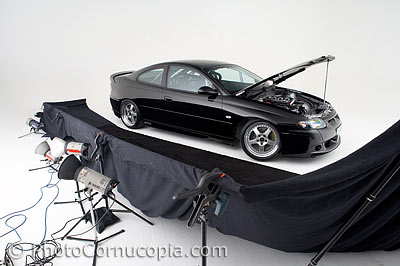 |
|
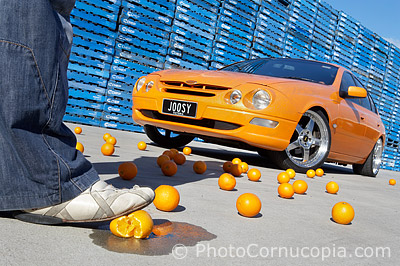 |
|
Do you have to use every piece of equipment that
you own to get a decent car photo? Probably not, but being lazy
won't help your cause either. |
|
An idea and a bag of oranges was all it took to
make this image. |
If you just want to take simple snaps, but make them better, then that's
still quite easy. It might just be a matter of moving a few inches this
way or that to reduce a horrible reflection in a panel or to prevent a
tree or power pole poking out of the roof or hood of a car. These are
simple and easy things to do yet it's surprising how often they are
ignored. There are lots of 'little' things you can do that all add up to
make a big difference. The following pages will try expand on these
little things that add up.
Ultimately, improving your car photography starts with getting a better
understanding of what makes a car photo good, bad or indifferent, with
your own preferences factoring into the equation, and then practicing
and improving your own skills. It's a good idea to collect a
large bunch of images, cut them out of magazines, for example, or
bookmark the images you like on the web, and try to understand what it
is about them that you like, why do they grab you, and how you think you
can either replicate, copy or improve that image. Don't be afraid to
'copy' an image you've seen as it's probably the best way to actually
learn. What tends to happen is that slowly your own style or preferences
blend into whatever you are doing and often result in a better image
than the original, well, with enough skill and practice.
The good, the bad and the indifferent
Good car photography essentially makes the car look desirable or
it portrays it in a way that is faithful to the cars style or character.
So it might make you want to buy the car, it might make you want to
drive the car, or it might tell you what the car really is or was (in
it's prime). A good car photo makes the car the star of the show, not an
extra. A good car photo could just be a pretty picture, it
doesn't have to be any more than that, but we are flooded with pretty
pictures so maybe it needs to be a bit more to stand out. It's not easy to define good car photography but at the same time
this gives the photographer a great deal of freedom to be creative.
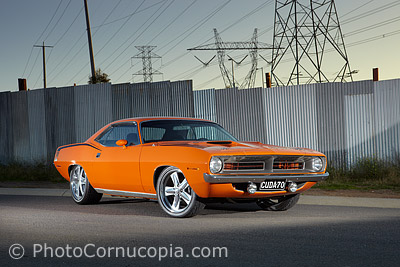 |
|
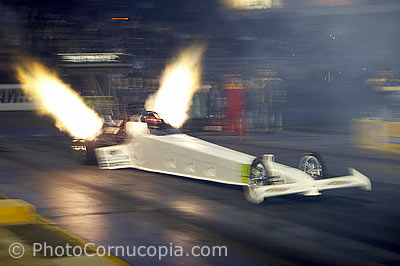 |
|
This is an example of a good, clean image, with no
significant post processing. The car stands out and is in an
appropriate location. |
|
This is what Top Fuel drag racing feels like when
you are actually there but
is this a bad image because nothing is sharp? |
Bad car photography is much easier to define. A bad car photo might make the car difficult to
properly see and it might blend into the background rather than stand
out from it. In general it's best to avoid having any unrelated cars in
the background, ie behind, the car being photographed, as it's quite
distracting. The shapes of the panels might be masked by all kinds of
reflections in them, or maybe due to the lighting method used. All manner of distracting poles, signs
or trees might
be poking out of them or the car might even be parked on top of
distracting line markings that either reflect in the car or otherwise
attract attention away from the car.
The car usually fights for
attention in a bad car photo.
There are also lots of
'technical' mistakes you can make too, such as possibly leaving a
window open, a sun visor may be down, air fresheners may be hanging
from the rear view mirror, the wheels might be turned the 'wrong' way
(towards the camera so that you can't see the wheel/rim), aerial might
be left up or any number of minor things that distract from the clean
lines of the car. Avoid any road surface that you wouldn't reasonably
expect the car to be driven upon, particularly grass. Cows belong on
grass, not cars! Don't shoot cars on grass.
One sure way to take an indifferent car photo is to take a 'record' shot
of an exotic, a Ferrari, Lamborghini, <insert your favourite car>, and
expect it to be a great photo because of the subject. The cost and
exclusivity of the car is irrelevant to the quality of the photo. That
is a fact. Photograph the cars you like, be they exotics, customs, hot
rods, whatever, but keep in mind that whilst you can take a record shot
and appreciate it very much, you can also make a much better photo if
given the opportunity to do so, a photo that might be appreciated by
people who don't necessarily appreciate the car itself.
Concepts, Composition, Location and Lighting
It's the concept, idea, look or style
of the image that sets one automotive image apart from another, not just
the car being photographed. Finding
the right idea or concept is the beginning of the entire
process and drives the entire shoot. It's important to marry the
cars personality with the look or feel of the image. These concepts are
then executed through careful location selection, composition, lighting
and post processing.
Car Photography To-Day
Today an image is commonly the end result of a process which starts with
a camera but ends at a computer. Photography is now a combination of
'camera-craft' and 'computer-craft'. If you are good at the camera-craft
component, ie twiddling with lenses, filters, lighting etc then you will
certainly have a good base to start however a lack of computer-craft, ie.
post processing or 'editing' skills, will be a major disadvantage as
this is arguably now the more important component of the two.
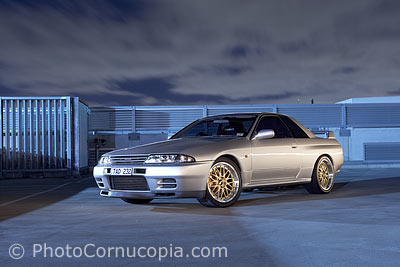 |
|
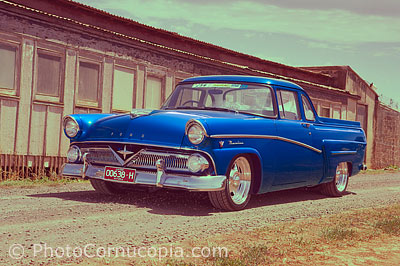 |
|
The effects in this image were created with
lighting and not post processing. |
|
Relatively simple
post processing was used here to create a vintage look which is
supported by the choice of location. |
It can be very difficult to achieve a strong image straight out of the
camera, without minimal or even significant post processing. Conversely
it can be relatively easy, although time consuming, to create a very
strong image which started from a very poor one. It seems that a lot of
people love the computer side so are expert at it but only 'put up' with
the camera side having very little knowledge of what used to be called
photography. Ideally one should be competent, even expert, at both.





